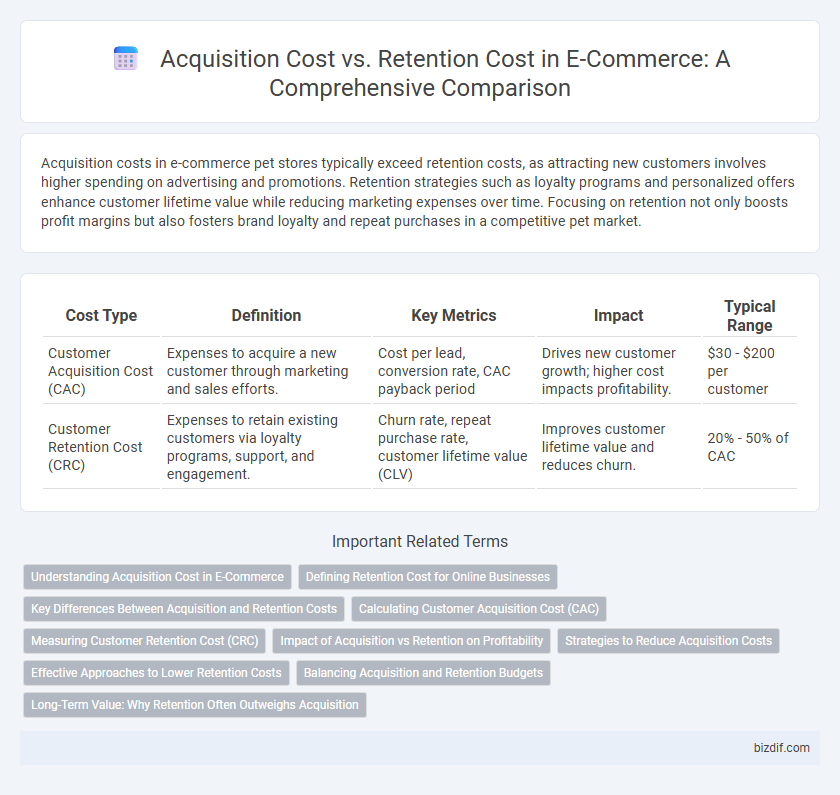Acquisition costs in e-commerce pet stores typically exceed retention costs, as attracting new customers involves higher spending on advertising and promotions. Retention strategies such as loyalty programs and personalized offers enhance customer lifetime value while reducing marketing expenses over time. Focusing on retention not only boosts profit margins but also fosters brand loyalty and repeat purchases in a competitive pet market.
Table of Comparison
| Cost Type | Definition | Key Metrics | Impact | Typical Range |
|---|---|---|---|---|
| Customer Acquisition Cost (CAC) | Expenses to acquire a new customer through marketing and sales efforts. | Cost per lead, conversion rate, CAC payback period | Drives new customer growth; higher cost impacts profitability. | $30 - $200 per customer |
| Customer Retention Cost (CRC) | Expenses to retain existing customers via loyalty programs, support, and engagement. | Churn rate, repeat purchase rate, customer lifetime value (CLV) | Improves customer lifetime value and reduces churn. | 20% - 50% of CAC |
Understanding Acquisition Cost in E-Commerce
Customer acquisition cost (CAC) in e-commerce refers to the total expense incurred to attract a new customer, including marketing, advertising, and promotional efforts. Precise calculation of CAC involves dividing the total acquisition spend by the number of new customers acquired within a specific period. Understanding CAC is crucial for optimizing marketing budgets and ensuring profitability in competitive online retail markets.
Defining Retention Cost for Online Businesses
Retention cost for online businesses encompasses expenses related to maintaining customer loyalty and encouraging repeat purchases, such as email marketing campaigns, loyalty programs, personalized offers, customer support, and subscription management. These costs often prove more cost-effective than acquisition expenses by increasing customer lifetime value (CLV) and reducing churn rates. Efficient investment in retention strategies enhances overall profitability by fostering long-term customer relationships and driving sustainable revenue growth.
Key Differences Between Acquisition and Retention Costs
Acquisition cost refers to the expenses involved in attracting new customers, including marketing campaigns, advertising, and promotions, while retention cost focuses on maintaining existing customers through loyalty programs, customer service, and personalized experiences. Acquisition costs are typically higher due to the efforts needed to convert prospects into buyers, whereas retention costs tend to be lower but require consistent investment to foster long-term relationships. Understanding these key differences helps e-commerce businesses allocate budgets effectively to balance growth and customer lifetime value.
Calculating Customer Acquisition Cost (CAC)
Customer Acquisition Cost (CAC) in e-commerce is calculated by dividing the total marketing and sales expenses by the number of new customers acquired during a specific period. This metric includes advertising spend, salaries of marketing personnel, software tools, and promotional offers aimed at attracting customers. Precise CAC calculation enables businesses to evaluate the efficiency of their marketing strategies and optimize budget allocation for customer acquisition.
Measuring Customer Retention Cost (CRC)
Measuring Customer Retention Cost (CRC) involves analyzing expenses related to loyalty programs, personalized marketing, customer service, and ongoing engagement initiatives. Tracking CRC alongside acquisition cost reveals the long-term profitability of retaining customers versus acquiring new ones. Optimizing CRC includes leveraging data analytics tools to monitor customer lifetime value (CLV) and adjust retention strategies effectively.
Impact of Acquisition vs Retention on Profitability
Acquisition cost typically exceeds retention cost, making customer retention a more cost-effective strategy for sustainable profitability in e-commerce. Retained customers generate higher lifetime value through repeat purchases and reduced marketing expenses, directly boosting profit margins. E-commerce businesses prioritizing retention often experience increased ROI, improved customer loyalty, and enhanced overall financial stability.
Strategies to Reduce Acquisition Costs
Optimizing customer acquisition costs involves leveraging targeted advertising on platforms like Facebook and Google to attract high-intent shoppers efficiently. Implementing referral programs and strategic influencer partnerships can amplify brand reach while minimizing spend. Utilizing data analytics to refine audience segmentation and personalize marketing messages enhances conversion rates and lowers cost per acquisition.
Effective Approaches to Lower Retention Costs
Lowering retention costs in e-commerce involves leveraging personalized email marketing and loyalty programs to increase customer engagement and repeat purchases. Implementing advanced CRM systems enables targeted promotions that enhance customer lifetime value while minimizing unnecessary expenditures. Optimizing automated retention campaigns reduces manual efforts, resulting in significant cost savings without compromising customer satisfaction.
Balancing Acquisition and Retention Budgets
Balancing acquisition and retention budgets is crucial for e-commerce profitability, as acquisition cost per customer typically exceeds retention cost by up to five times. Investing in retention strategies like personalized email campaigns, loyalty programs, and customer feedback loops can significantly reduce churn rates and increase customer lifetime value (CLV). Optimizing budget allocation with data-driven insights ensures sustainable growth by acquiring high-quality customers while maximizing the value of existing ones.
Long-Term Value: Why Retention Often Outweighs Acquisition
Retention cost in e-commerce is significantly lower than acquisition cost, making it more economically efficient to nurture existing customers. The long-term value of retained customers includes higher purchase frequency and increased average order value, which boosts overall profitability. Prioritizing retention strategies, such as personalized marketing and loyalty programs, drives sustainable growth by maximizing customer lifetime value (CLV).
Acquisition Cost vs Retention Cost Infographic

 bizdif.com
bizdif.com